Impacts of Climate Change on the Biogeography and Ecological Structure of Zelkova schneideriana Hand.-Mazz. in China
Abstract
1. Introduction
2. Results
2.1. Accuracy of the Model’s Predicted Results
2.2. Changes in the Distribution Area of Zelkova schneideriana
2.3. Changes in the Latitude and Elevation of the Distribution Area of Zelkova schneideriana
2.4. Internal Structural Changes in the Distribution Area of Zelkova schneideriana
2.5. Factors Influencing Changes in the Distribution Area of Zelkova schneideriana
3. Discussion
3.1. Factors Influencing the Distribution Area of Zelkova schneideriana
3.2. Range Changes of the Distribution Area of Zelkova schneideriana
3.3. Fragmentation of Distribution Range Landscape
4. Materials and Methods
4.1. Data Collection
4.2. Species Distribution Model
4.3. Analysis of Factors Influencing Changes in Distribution Range
4.4. Analysis of Changes in Distribution Range
5. Conclusions
Author Contributions
Funding
Data Availability Statement
Conflicts of Interest
References
- Hooper, D.U.; Adair, E.C.; Cardinale, B.J.; Byrnes, J.E.K.; Hungate, B.A.; Matulich, K.L.; Gonzalez, A.; Duffy, J.E.; Gamfeldt, L.; O’Connor, M.I. A global synthesis reveals biodiversity loss as a major driver of ecosystem change. Nature 2012, 486, 105–108. [Google Scholar] [CrossRef] [PubMed]
- Santos, M.J.; Smith, A.B.; Dekker, S.C.; Eppinga, M.B.; Leitão, P.J.; Moreno-Mateos, D.; Morueta-Holme, N.; Ruggeri, M. The role of land use and land cover change in climate change vulnerability assessments of biodiversity: A systematic review. Landsc. Ecol. 2021, 36, 3367–3382. [Google Scholar] [CrossRef]
- Habibullah, M.S.; Din, B.H.; Tan, S.-H.; Zahid, H. Impact of climate change on biodiversity loss: Global evidence. Environ. Sci. Pollut. Res. 2022, 29, 1073–1086. [Google Scholar] [CrossRef] [PubMed]
- Pigot, A.L.; Merow, C.; Wilson, A.; Trisos, C.H. Abrupt expansion of climate change risks for species globally. Nat. Ecol. Evol. 2023, 7, 1060–1071. [Google Scholar] [CrossRef] [PubMed]
- Bellard, C.; Bertelsmeier, C.; Leadley, P.; Thuiller, W.; Courchamp, F. Impacts of climate change on the future of biodiversity. Ecol. Lett. 2012, 15, 365–377. [Google Scholar] [CrossRef] [PubMed]
- Pugnaire, F.I.; Morillo, J.A.; Peñuelas, J.; Reich, P.B.; Bardgett, R.D.; Gaxiola, A.; Wardle, D.A.; van der Putten, W.H. Climate change effects on plant-soil feedbacks and consequences for biodiversity and functioning of terrestrial ecosystems. Sci. Adv. 2019, 5, eaaz1834. [Google Scholar] [CrossRef] [PubMed]
- Sintayehu, D.W. Impact of climate change on biodiversity and associated key ecosystem services in Africa: A systematic review. Ecosyst. Health Sustain. 2018, 4, 225–239. [Google Scholar] [CrossRef]
- Oke, T.A.; Stralberg, D.; Reid, D.G.; Bennett, B.A.; Cannings, S.; Willier, C.; Fulkerson, J.R.; Cooke, H.A.; Mantyka-Pringle, C.S. Warming drives poleward range contractions of Beringian endemic plant species at high latitudes. Divers. Distrib. 2023, 29, 509–523. [Google Scholar] [CrossRef]
- Burrows, M.T.; Schoeman, D.S.; Richardson, A.J.; Molinos, J.G.; Hoffmann, A.; Buckley, L.B.; Moore, P.J.; Brown, C.J.; Bruno, J.F.; Duarte, C.M.; et al. Geographical limits to species-range shifts are suggested by climate velocity. Nature 2014, 507, 492–495. [Google Scholar] [CrossRef]
- Lenoir, J.; Gégout, J.C.; Marquet, P.A.; de Ruffray, P.; Brisse, H. A Significant Upward Shift in Plant Species Optimum Elevation During the 20th Century. Science 2008, 320, 1768–1771. [Google Scholar] [CrossRef]
- Lenoir, J.; Gégout, J.-C.; Guisan, A.; Vittoz, P.; Wohlgemuth, T.; Zimmermann, N.E.; Dullinger, S.; Pauli, H.; Willner, W.; Svenning, J.-C. Going against the flow: Potential mechanisms for unexpected downslope range shifts in a warming climate. Ecography 2010, 33, 295–303. [Google Scholar] [CrossRef]
- Marques, A.; Martins, I.S.; Kastner, T.; Plutzar, C.; Theurl, M.C.; Eisenmenger, N.; Huijbregts, M.A.J.; Wood, R.; Stadler, K.; Bruckner, M.; et al. Increasing impacts of land use on biodiversity and carbon sequestration driven by population and economic growth. Nat. Ecol. Evol. 2019, 3, 628–637. [Google Scholar] [CrossRef]
- Brondizio, E.S.; Settele, J.; Diaz, S.; Ngo, H.T. Global Assessment Report on Biodiversity and Ecosystem Services of the Intergovernmental Science-Policy Platform on Biodiversity and Ecosystem Services; IPBES Secretariat: Bonn, Germany, 2019. [Google Scholar] [CrossRef]
- VanDerWal, J.; Murphy, H.T.; Kutt, A.S.; Perkins, G.C.; Bateman, B.L.; Perry, J.J.; Reside, A.E. Focus on poleward shifts in species’ distribution underestimates the fingerprint of climate change. Nat. Clim. Chang. 2013, 3, 239–243. [Google Scholar] [CrossRef]
- Della Rocca, F.; Milanesi, P. Combining climate, land use change and dispersal to predict the distribution of endangered species with limited vagility. J. Biogeogr. 2020, 47, 1427–1438. [Google Scholar] [CrossRef]
- Song, H.J.; Ordonez, A.; Svenning, J.-C.; Qian, H.; Yin, X.; Mao, L.F.; Deng, T.; Zhang, J. Regional disparity in extinction risk: Comparison of disjunct plant genera between eastern Asia and eastern North America. Glob. Chang. Biol. 2021, 27, 1904–1914. [Google Scholar] [CrossRef] [PubMed]
- Chen, B.R.; Zou, H.; Zhang, B.Y.; Zhang, X.Y.; Wang, C.; Zhang, X.X. Distribution change and protected area planning of Tilia amurensis in China: A study of integrating the climate change and present habitat landscape pattern. Glob. Ecol. Conserv. 2023, 43, e02438. [Google Scholar] [CrossRef]
- Zhang, R.Q.; Yang, J.; Jin, X.L.; Tang, C.F.; Liu, H.L. Dynamic activity of endogenous plant hormones in Zelkova schneideriana during the growth of seedlings. Non-Wood For. Res. 2011, 29, 1–5. [Google Scholar]
- Cao, Y.F.; Liu, Z.H.; Zhao, H.E. Preliminary Investigation on the Suitability of Some Deciduous Broad-leaved Trees in Beijing. J. Chin. Landsc. Archit. 2005, 8, 62–66. [Google Scholar]
- Jin, X.L.; Zhang, R.Q.; Zhang, D.L.; He, P.; Cao, F.X. In vitro plant regeneration of Zelkova schneideriana, an endangered woody species in China, from leaf explants. J. Hortic. Sci. Biotechnol. 2009, 84, 415–420. [Google Scholar] [CrossRef]
- Ma, F.; Zhang, J.L. Investigation on Key Protected Wild Plant Resources in China; China Forestry Publishing House: Beijing, China, 2009. [Google Scholar]
- Shao, L.; Zhang, G. Niche and interspecific association of dominant tree populations of Zelkova schneideriana communities in eastern China. Bot. Sci. 2021, 99, 823–833. [Google Scholar] [CrossRef]
- Zhou, Y.R.; Lu, X.; Zhang, G.F. Potentially differential impacts on niche overlap between Chinese endangered Zelkova schneideriana and its associated tree species under climate change. Front. Ecol. Evol. 2023, 11, 1218149. [Google Scholar] [CrossRef]
- Fu, L.K.; Jin, J.M. China Plant Red Data Book-Rare and Endangered Plants; Science Press: Beijing, China, 1992; Volume 1. [Google Scholar]
- Liu, H.L.; Zhang, R.Q.; Geng, M.L.; Zhu, J.Y.; An, J.C.; Ma, J.L. Chloroplast analysis of Zelkova schneideriana (Ulmaceae): Genetic diversity, population structure, and conservation implications. Genet. Mol. Res. 2016, 15, 1–9. [Google Scholar] [CrossRef] [PubMed]
- Sun, J.J.; Qiu, H.J.; Guo, J.H.; Xu, X.; Wu, D.T.; Zhong, L.; Jiang, B.; Jiao, J.J.; Yuan, W.G.; Huang, Y.J.; et al. Modeling the potential distribution of Zelkova schneideriana under different human activity intensities and climate change patterns in China. Glob. Ecol. Conserv. 2020, 21, e00840. [Google Scholar] [CrossRef]
- Titeux, N.; Henle, K.; Mihoub, J.-B.; Regos, A.; Geijzendorffer, I.R.; Cramer, W.; Verburg, P.H.; Brotons, L. Biodiversity scenarios neglect future land-use changes. Glob. Chang. Biol. 2016, 22, 2505–2515. [Google Scholar] [CrossRef]
- Curd, A.; Chevalier, M.; Vasquez, M.; Boyé, A.; Firth, L.B.; Marzloff, M.P.; Bricheno, L.M.; Burrows, M.T.; Bush, L.E.; Cordier, C.; et al. Applying landscape metrics to species distribution model predictions to characterize internal range structure and associated changes. Glob. Chang. Biol. 2023, 29, 631–647. [Google Scholar] [CrossRef] [PubMed]
- Lausch, A.; Blaschke, T.; Haase, D.; Herzog, F.; Syrbe, R.-U.; Tischendorf, L.; Walz, U. Understanding and quantifying landscape structure—A review on relevant process characteristics, data models and landscape metrics. Ecol. Model. 2015, 295, 31–41. [Google Scholar] [CrossRef]
- Wang, C.; Sheng, Q.Q.; Zhao, R.N.; Zhu, Z.L. Differences in the Suitable Distribution Area between Northern and Southern China Landscape Plants. Plants 2023, 12, 2710. [Google Scholar] [CrossRef]
- He, Y.L.; Ma, J.M.; Chen, G.S. Potential geographical distribution and its multi-factor analysis of Pinus massoniana in China based on the maxent model. Ecol. Indic. 2023, 154, 110790. [Google Scholar] [CrossRef]
- Sun, S.X.; Zhang, Y.; Huang, D.Z.; Wang, H.; Cao, Q.; Fan, P.X.; Yang, N.; Zheng, P.M.; Wang, R.Q. The effect of climate change on the richness distribution pattern of oaks (Quercus L.) in China. Sci. Total Environ. 2020, 744, 140786. [Google Scholar] [CrossRef]
- Wang, Y.Y.; Chao, B.X.; Dong, P.; Zhang, D.; Yu, W.W.; Hu, W.J.; Ma, Z.Y.; Chen, G.C.; Liu, Z.H.; Chen, B. Simulating spatial change of mangrove habitat under the impact of coastal land use: Coupling MaxEnt and Dyna-CLUE models. Sci. Total Environ. 2021, 788, 147914. [Google Scholar] [CrossRef]
- Shi, X.D.; Wang, J.W.; Zhang, L.; Chen, S.X.; Zhao, A.L.; Ning, X.D.; Fan, G.R.; Wu, N.S.; Zhang, L.; Wang, Z.D. Prediction of the potentially suitable areas of Litsea cubeba in China based on future climate change using the optimized MaxEnt model. Ecol. Indic. 2023, 148, 110093. [Google Scholar] [CrossRef]
- Xie, C.P.; Li, M.; Chen, L.; Jim, C.Y. Climate-driven changes to the spatial–temporal pattern of endangered tree Toona ciliata Roem. in China. Theor. Appl. Climatol. 2023, 1–15. [Google Scholar] [CrossRef]
- Kuhn, E.; Gégout, J.-C. Highlighting declines of cold-demanding plant species in lowlands under climate warming. Ecography 2019, 42, 36–44. [Google Scholar] [CrossRef]
- Mamet, S.D.; Brown, C.D.; Trant, A.J.; Laroque, C.P. Shifting global Larix distributions: Northern expansion and southern retraction as species respond to changing climate. J. Biogeogr. 2019, 46, 30–44. [Google Scholar] [CrossRef]
- Loarie, S.R.; Duffy, P.B.; Hamilton, H.; Asner, G.P.; Field, C.B.; Ackerly, D.D. The velocity of climate change. Nature 2009, 462, 1052–1055. [Google Scholar] [CrossRef] [PubMed]
- Liao, J.H. Study on the Growth Law and the Community Characteristics of Zelkova Schneideriana in Northwest of Guangxi. Master’s Thesis, Guangxi University, Nanning, China, 2014. [Google Scholar]
- Soomers, H.; Karssenberg, D.; Verhoeven, J.T.A.; Verweij, P.A.; Wassen, M.J. The effect of habitat fragmentation and abiotic factors on fen plant occurrence. Biodivers. Conserv. 2013, 22, 405–424. [Google Scholar] [CrossRef]
- Ozinga, W.A.; Römermann, C.; Bekker, R.M.; Prinzing, A.; Tamis, W.L.M.; Schaminée, J.H.J.; Hennekens, S.M.; Thompson, K.; Poschlod, P.; Kleyer, M.; et al. Dispersal failure contributes to plant losses in NW Europe. Ecol. Lett. 2009, 12, 66–74. [Google Scholar] [CrossRef] [PubMed]
- Jump, A.S.; Peñuelas, J. Running to stand still: Adaptation and the response of plants to rapid climate change. Ecol. Lett. 2005, 8, 1010–1020. [Google Scholar] [CrossRef]
- Turbek, S.P.; Taylor, S.A. Hybridization provides climate resilience. Nat. Clim. Chang. 2023, 13, 212–213. [Google Scholar] [CrossRef]
- Brauer, C.J.; Sandoval-Castillo, J.; Gates, K.; Hammer, M.P.; Unmack, P.J.; Bernatchez, L.; Beheregaray, L.B. Natural hybridization reduces vulnerability to climate change. Nat. Clim. Chang. 2023, 13, 282–289. [Google Scholar] [CrossRef]
- Zhang, B.Y.; Zou, H.; Chen, B.R.; Zhang, X.Y.; Kang, X.; Wang, C.; Zhang, X.X. Optimizing the distribution pattern of species under climate change: The protection and management of Phellodendron amurense in China. Front. Ecol. Evol. 2023, 11, 1186627. [Google Scholar] [CrossRef]
- Wu, T.W.; Lu, Y.X.; Fang, Y.J.; Xin, X.G.; Li, L.; Li, W.P.; Jie, W.H.; Zhang, J.; Liu, Y.M.; Zhang, L.; et al. The Beijing Climate Center Climate System Model (BCC-CSM): The main progress from CMIP5 to CMIP6. Geosci. Model Dev. 2019, 12, 1573–1600. [Google Scholar] [CrossRef]
- Xin, X.G.; Wu, T.W.; Zhang, J.; Zhang, F.; Li, W.P.; Zhang, Y.W.; Lu, Y.X.; Fang, Y.J.; Jie, W.H.; Zhang, L.; et al. Introduction of BCC models and its participation in CMIP6. Adv. Clim. Change Res. 2019, 15, 533. [Google Scholar] [CrossRef]
- Moss, R.H.; Edmonds, J.A.; Hibbard, K.A.; Manning, M.R.; Rose, S.K.; van Vuuren, D.P.; Carter, T.R.; Emori, S.; Kainuma, M.; Kram, T.; et al. The next generation of scenarios for climate change research and assessment. Nature 2010, 463, 747–756. [Google Scholar] [CrossRef]
- Chen, G.Z.; Li, X.; Liu, X.P. Global land projection based on plant functional types with a 1-km resolution under socio-climatic scenarios. Sci. Data 2022, 9, 125. [Google Scholar] [CrossRef] [PubMed]
- Mendoza-Fernández, A.J.; Martínez-Hernández, F.; Salmerón-Sánchez, E.; Pérez-García, F.J.; Teruel, B.; Merlo, M.E.; Mota, J.F. The Relict Ecosystem of Maytenus senegalensis subsp. europaea in an Agricultural Landscape: Past, Present and Future Scenarios. Land 2021, 10, 1. [Google Scholar] [CrossRef]
- Guo, Y.L.; Zhao, Z.F.; Zhu, F.X.; Gao, B. The impact of global warming on the potential suitable planting area of Pistacia chinensis is limited. Sci. Total Environ. 2023, 864, 161007. [Google Scholar] [CrossRef] [PubMed]
- Nelder, J.A.; Wedderburn, R.W.M. Generalized Linear Models. J. R. Stat. Soc. 1972, 135, 370–384. [Google Scholar] [CrossRef]
- Friedman, J.H. Greedy Function Approximation: A Gradient Boosting Machine. Ann. Stat. 2001, 29, 1189–1232. [Google Scholar] [CrossRef]
- Phillips, S.J.; Anderson, R.P.; Dudík, M.; Schapire, R.E.; Blair, M.E. Opening the black box: An open-source release of Maxent. Ecography 2017, 40, 887–893. [Google Scholar] [CrossRef]
- Breiman, L. Random Forests. Mach. Learn. 2001, 45, 5–32. [Google Scholar] [CrossRef]
- Franklin, J. Mapping Species Distributions: Spatial Inference and Prediction; Cambridge University Press: Cambridge, UK, 2010. [Google Scholar]
- Barbet-Massin, M.; Jiguet, F.; Albert, C.H.; Thuiller, W. Selecting pseudo-absences for species distribution models: How, where and how many? Methods Ecol. Evol. 2012, 3, 327–338. [Google Scholar] [CrossRef]
- Thuiller, W.; Lafourcade, B.; Engler, R.; Araújo, M.B. BIOMOD—A platform for ensemble forecasting of species distributions. Ecography 2009, 32, 369–373. [Google Scholar] [CrossRef]
- Allouche, O.; Tsoar, A.; Kadmon, R. Assessing the accuracy of species distribution models: Prevalence, kappa and the true skill statistic (TSS). J. Appl. Ecol. 2006, 43, 1223–1232. [Google Scholar] [CrossRef]
- Lobo, J.M.; Jiménez-Valverde, A.; Real, R. AUC: A misleading measure of the performance of predictive distribution models. Glob. Ecol. Biogeogr. 2008, 17, 145–151. [Google Scholar] [CrossRef]
- Tagliari, M.M.; Danthu, P.; Leong Pock Tsy, J.-M.; Cornu, C.; Lenoir, J.; Carvalho-Rocha, V.; Vieilledent, G. Not all species will migrate poleward as the climate warms: The case of the seven baobab species in Madagascar. Glob. Chang. Biol. 2021, 27, 6071–6085. [Google Scholar] [CrossRef]

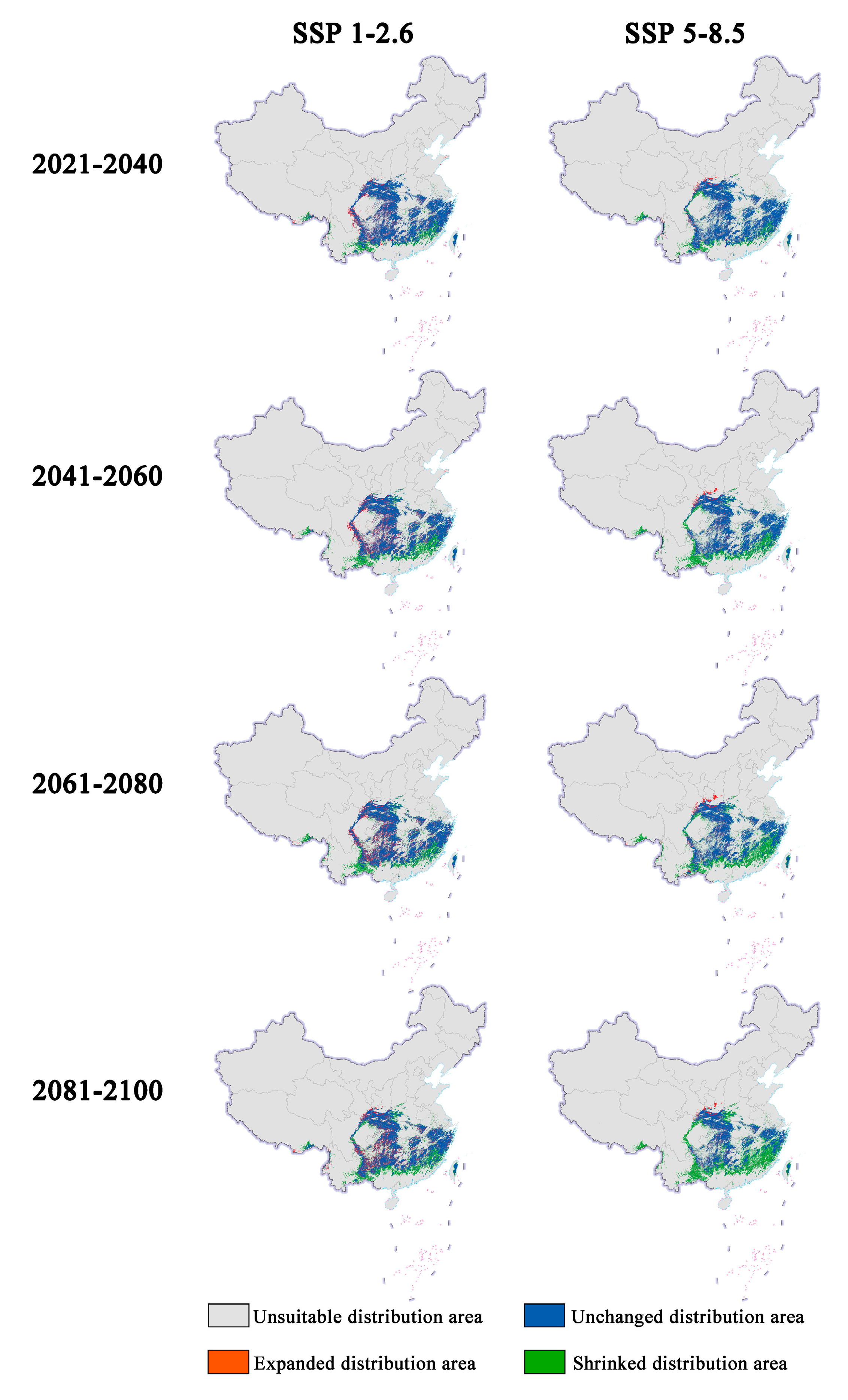
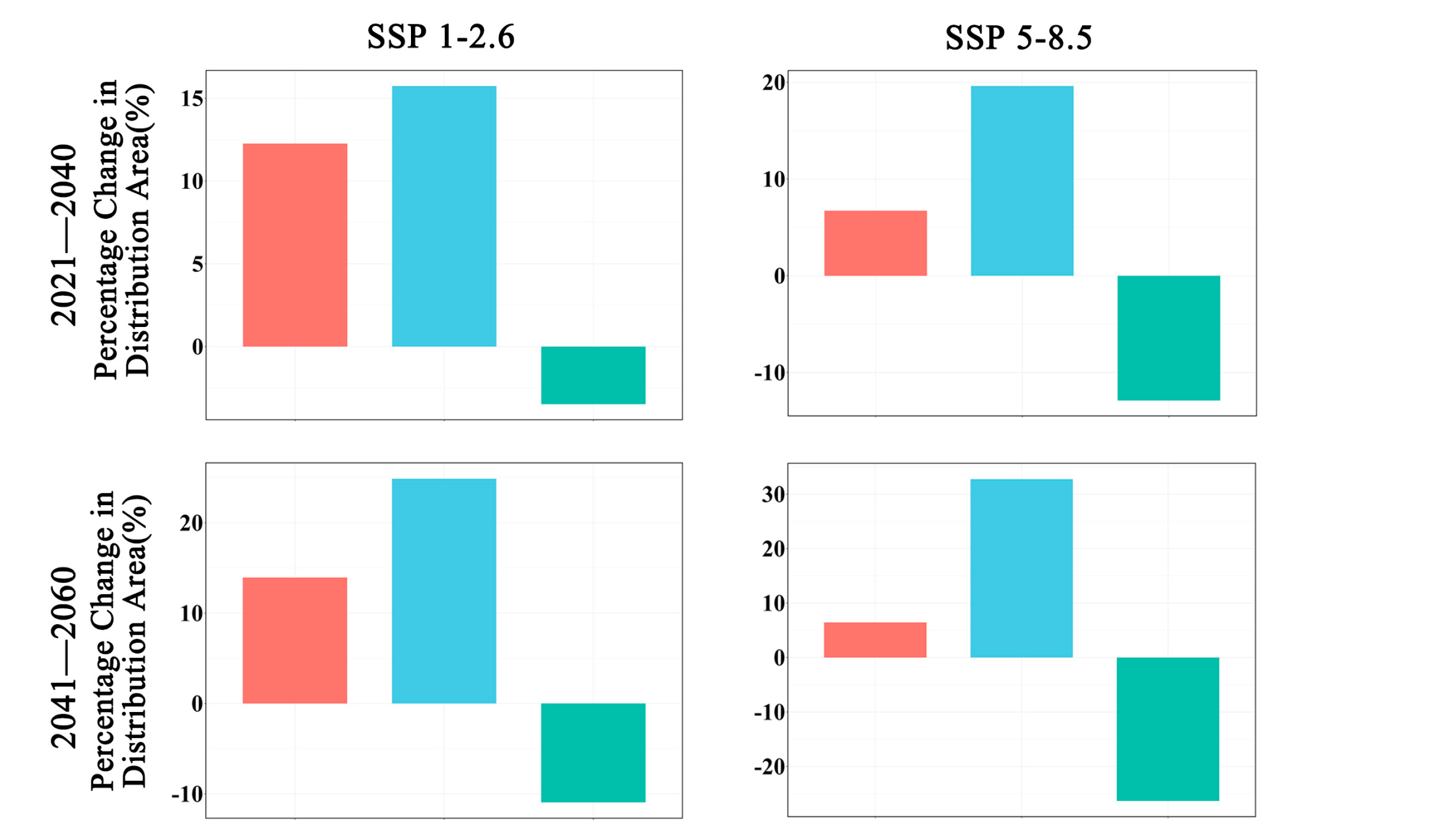
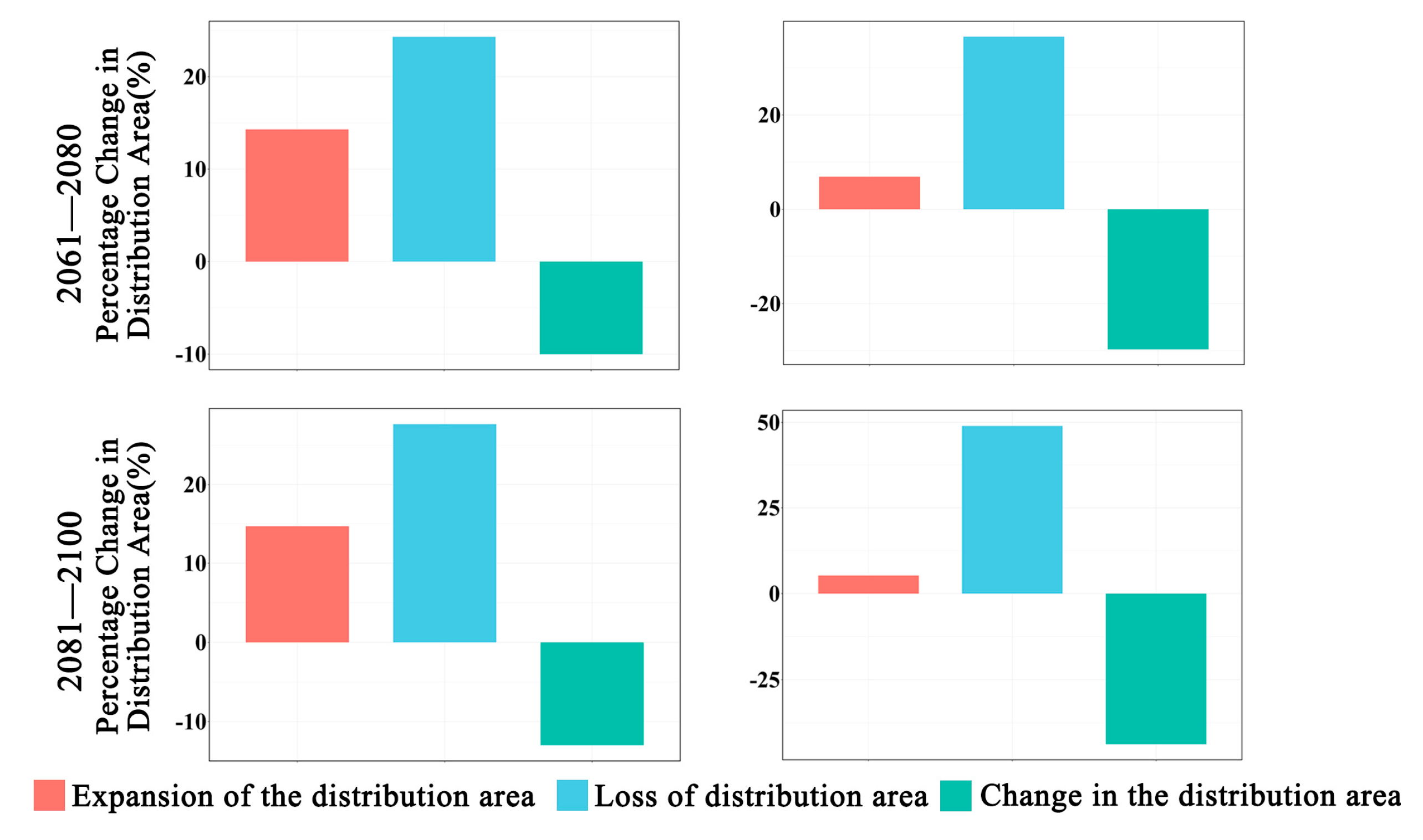
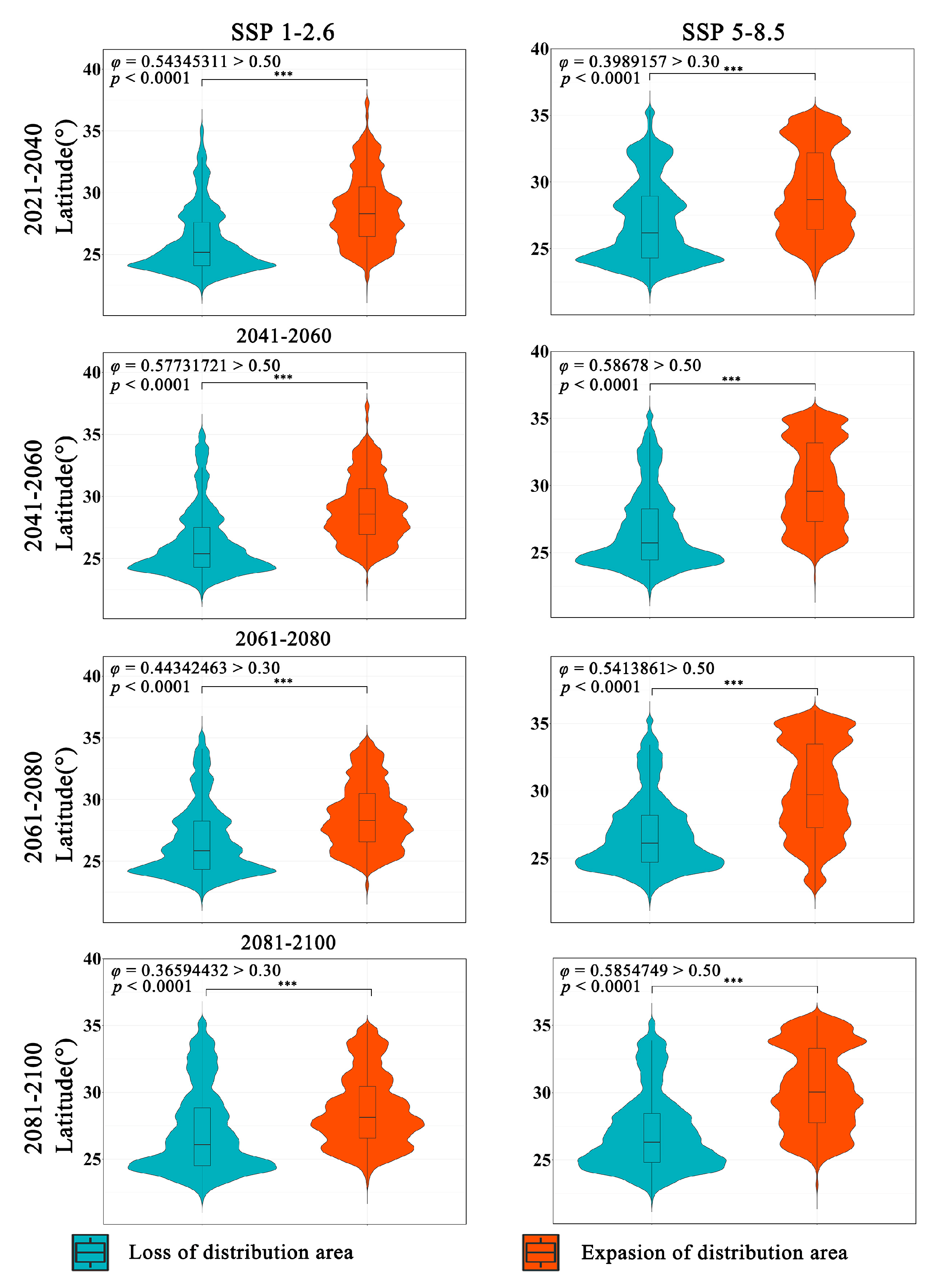
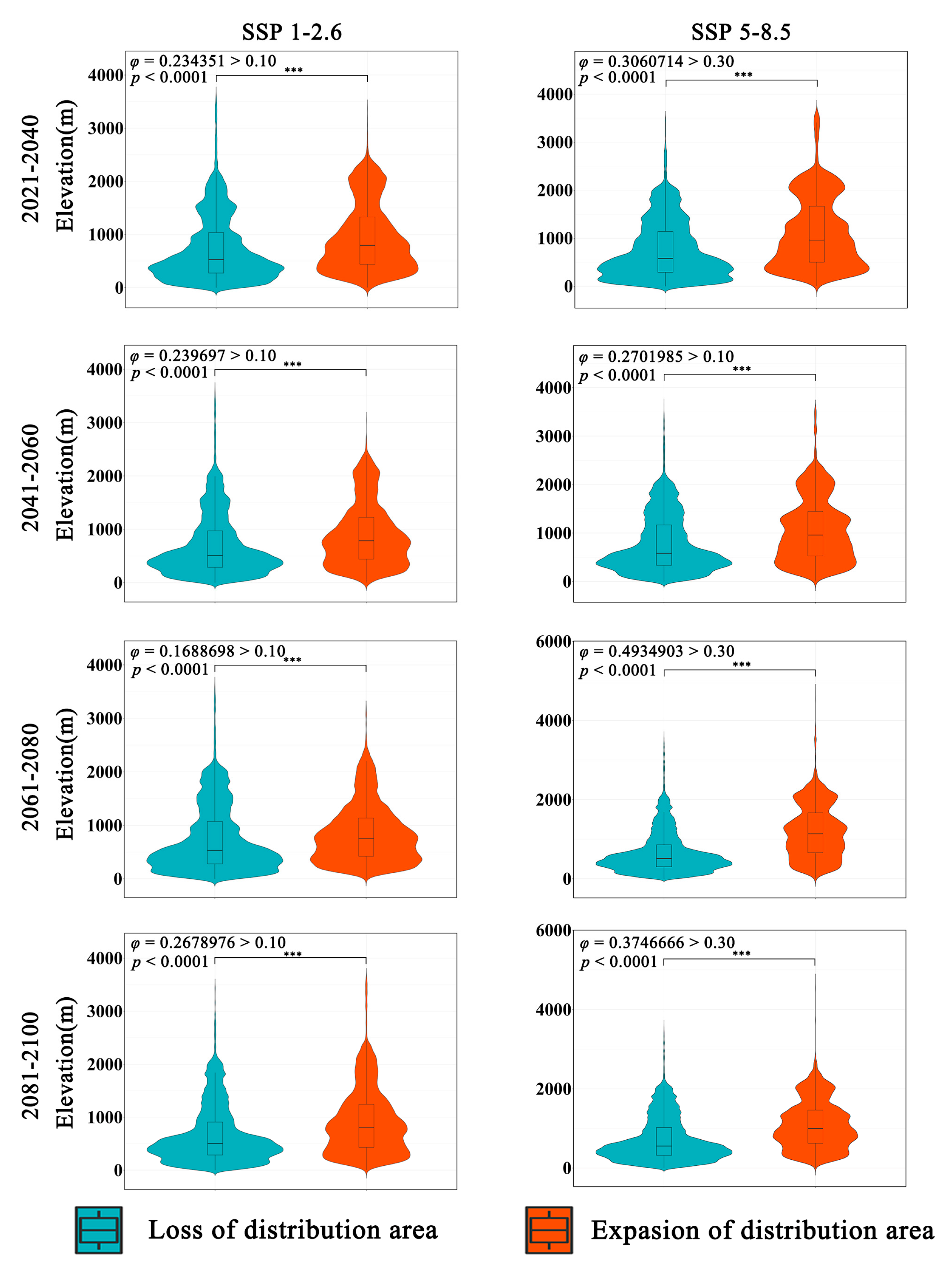
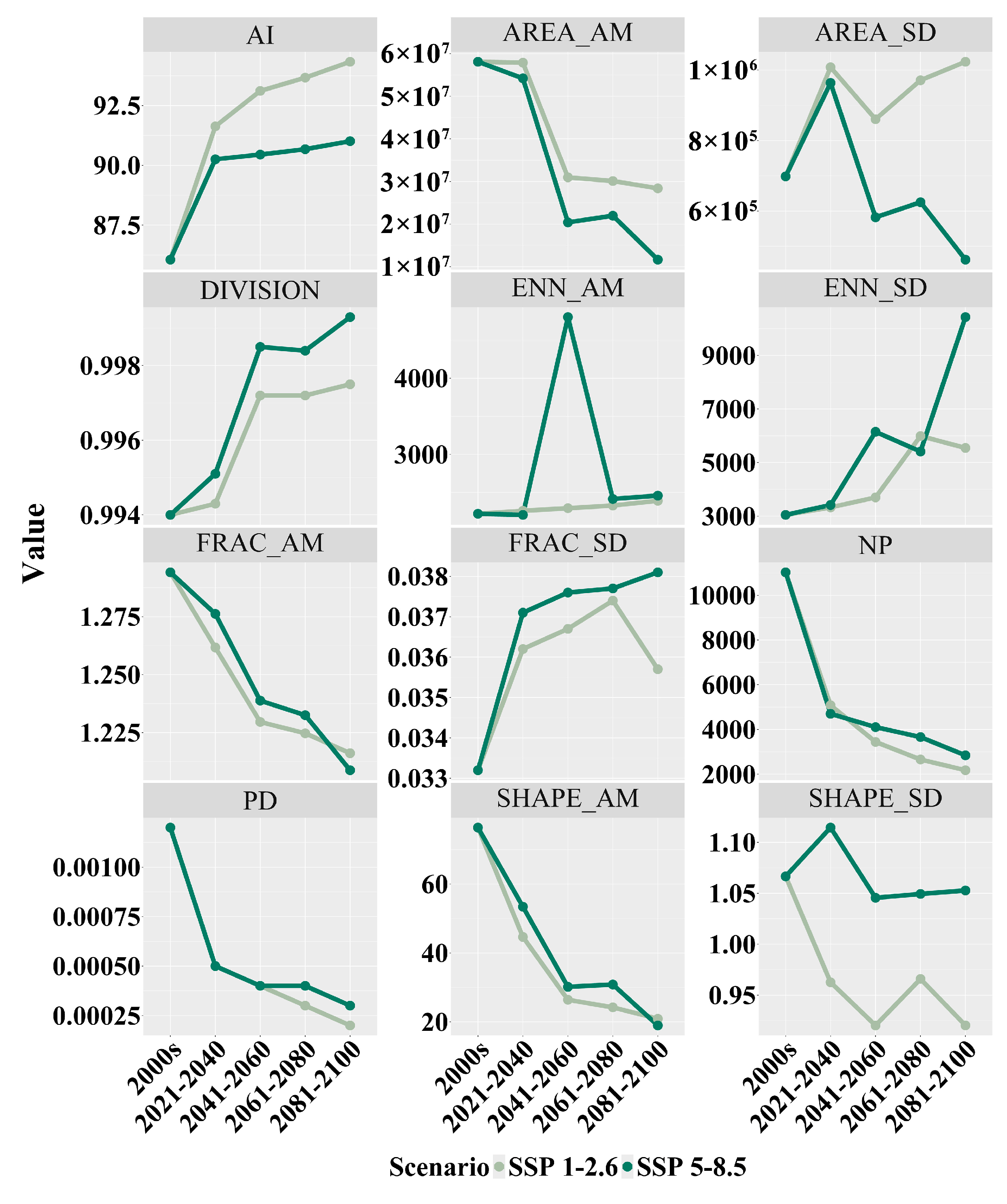

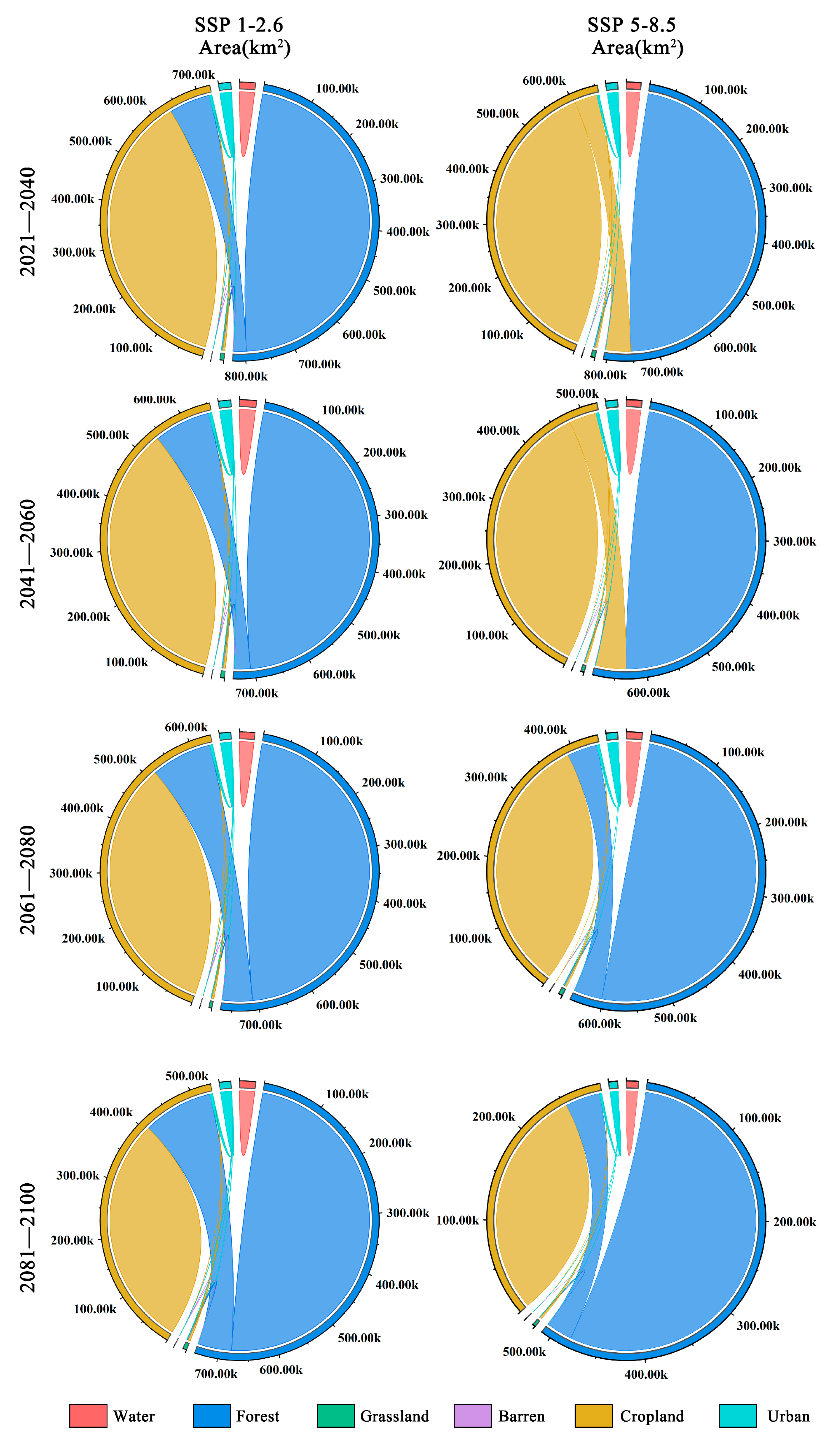

| Metric | Sensitivity | Specificity | Calibration |
|---|---|---|---|
| TSS | 96.474 | 83.997 | 0.805 |
| AUC | 96.513 | 84.936 | 0.956 |
| Environment Variables | Relative Contribution |
|---|---|
| Bio6 | 50.5% |
| Bio2 | 28.5% |
| Bio15 | 13.4% |
| Elevation | 7.6% |
| Scenario | Time | Code | 95% Quantiles | Mean | Units | |
|---|---|---|---|---|---|---|
| 2.5% | 97.5% | |||||
| Current | 2000s | Bio6 | −5.465 | 6.353 | 0.796 | °C |
| SSP1-2.6 | 2021–2040 | Bio6 | −3.903 | 7.300 | 2.060 | |
| 2041–2060 | Bio6 | −3.605 | 8.000 | 2.561 | ||
| 2061–2080 | Bio6 | −3.600 | 7.903 | 2.701 | ||
| 2081–2100 | Bio6 | −3.102 | 8.600 | 3.449 | ||
| SSP5-8.5 | 2021–2040 | Bio6 | −2.903 | 7.502 | 2.672 | |
| 2041–2060 | Bio6 | −1.700 | 8.603 | 3.751 | ||
| 2061–2080 | Bio6 | −0.303 | 9.503 | 4.807 | ||
| 2081–2100 | Bio6 | −0.500 | 10.000 | 4.985 | ||
| Current | 2000s | Bio2 | 10.250 | 6.548 | 8.116 | °C |
| SSP1-2.6 | 2021–2040 | Bio2 | 10.367 | 6.773 | 8.424 | |
| 2041–2060 | Bio2 | 10.650 | 6.991 | 8.699 | ||
| 2061–2080 | Bio2 | 10.483 | 6.658 | 8.389 | ||
| 2081–2100 | Bio2 | 10.517 | 6.374 | 8.243 | ||
| SSP5-8.5 | 2021–2040 | Bio2 | 10.167 | 6.542 | 8.116 | |
| 2041–2060 | Bio2 | 10.425 | 6.841 | 8.425 | ||
| 2061–2080 | Bio2 | 10.450 | 6.816 | 8.499 | ||
| 2081–2100 | Bio2 | 10.842 | 7.308 | 8.971 | ||
| Current | 2000s | Bio15 | 85.917 | 46.595 | 62.784 | mm |
| SSP1-2.6 | 2021–2040 | Bio15 | 87.016 | 49.086 | 64.053 | |
| 2041–2060 | Bio15 | 85.576 | 49.588 | 63.162 | ||
| 2061–2080 | Bio15 | 89.904 | 46.841 | 65.417 | ||
| 2081–2100 | Bio15 | 86.647 | 44.537 | 63.900 | ||
| SSP5-8.5 | 2021–2040 | Bio15 | 87.585 | 47.330 | 63.172 | |
| 2041–2060 | Bio15 | 90.637 | 52.320 | 67.198 | ||
| 2061–2080 | Bio15 | 86.172 | 45.350 | 64.493 | ||
| 2081–2100 | Bio15 | 90.718 | 51.110 | 68.389 | ||
Disclaimer/Publisher’s Note: The statements, opinions and data contained in all publications are solely those of the individual author(s) and contributor(s) and not of MDPI and/or the editor(s). MDPI and/or the editor(s) disclaim responsibility for any injury to people or property resulting from any ideas, methods, instructions or products referred to in the content. |
© 2024 by the authors. Licensee MDPI, Basel, Switzerland. This article is an open access article distributed under the terms and conditions of the Creative Commons Attribution (CC BY) license (https://creativecommons.org/licenses/by/4.0/).
Share and Cite
Wang, C.; Zhang, Y.; Sheng, Q.; Zhu, Z. Impacts of Climate Change on the Biogeography and Ecological Structure of Zelkova schneideriana Hand.-Mazz. in China. Plants 2024, 13, 798. https://doi.org/10.3390/plants13060798
Wang C, Zhang Y, Sheng Q, Zhu Z. Impacts of Climate Change on the Biogeography and Ecological Structure of Zelkova schneideriana Hand.-Mazz. in China. Plants. 2024; 13(6):798. https://doi.org/10.3390/plants13060798
Chicago/Turabian StyleWang, Chen, Yuanlan Zhang, Qianqian Sheng, and Zunling Zhu. 2024. "Impacts of Climate Change on the Biogeography and Ecological Structure of Zelkova schneideriana Hand.-Mazz. in China" Plants 13, no. 6: 798. https://doi.org/10.3390/plants13060798
APA StyleWang, C., Zhang, Y., Sheng, Q., & Zhu, Z. (2024). Impacts of Climate Change on the Biogeography and Ecological Structure of Zelkova schneideriana Hand.-Mazz. in China. Plants, 13(6), 798. https://doi.org/10.3390/plants13060798





